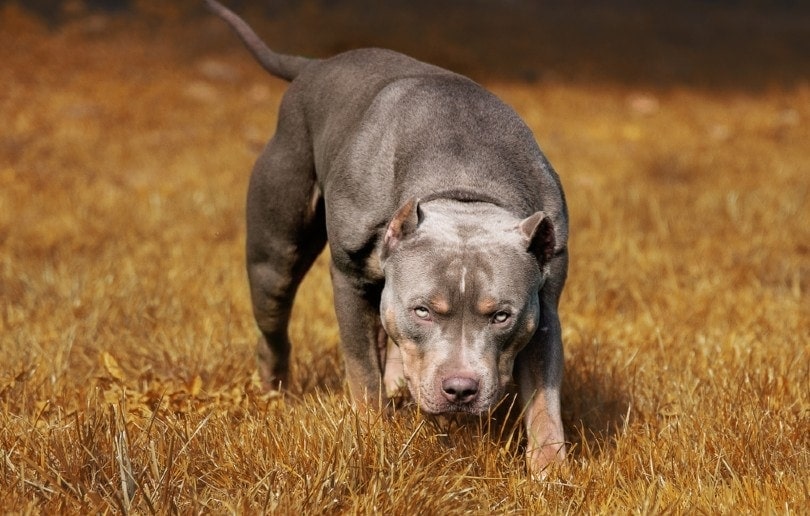National Pitbull Awareness Month 2024: What It Is & When It Is Held
Updated on

Pitbulls are one of the most misunderstood dog breeds out there, which is why Pitbull Awareness Month was established. Loosely established by Bless the Bullys as a month to spread awareness about Pitbulls, October is the official month for bullies everywhere.1 Unfairly maligned as aggressive fighting dogs, Pitbulls are some of the most loving, intelligent dogs out there.
To combat these misconceptions about the personality of Pitbulls as a breed, National Pitbull Awareness Month exists to spread positive awareness of the breed’s true nature. Spreading awareness is the main motivator, but helping to combat breed-specific legislation in certain states is relevant too.
Let’s delve into some more info about the Pitbull breed, including the source of their unsavory reputation and a bit more about breed-specific legislation targeting them.
About Pitbulls
The Pitbull Terrier, AKA the Pitbull, is a group of dog breeds including the American Pitbull Terrier and a few other closely related species. Over time, the Pitbull has been caricatured into a symbol of unrestrained aggression and poor dog ownership. This happened because of poor dog ownership education, unfair media coverage, and a rash of laws restricting Pitbull ownership in select American communities.
The real truth is that Pitbulls are an extremely affectionate dog breed with a wide range of personality traits perfect for existing or would-be dog parents. Sadly, due to the aforementioned stereotypes, people can have a skewed view of what a Pitbull is and what it can become. They’re much, much more than fighting dogs, which is a sad existence for any bully breed to begin with.

Are Pitbulls More Aggressive Than Other Dog Breeds?
There’s no scientific evidence to suggest that Pitbulls are a more aggressive breed on average versus most other large dog breeds. However, in some cases, a handful of Pitbull bloodlines may be more unpredictably aggressive, which gives the breed at large a bad rap.
Dogs are bred based on traits, and some Pitbull lines have been bred for traits like aggression and fighting ability. Breeding for traits like an affectionate nature or appearance are generally more common. According to the ASPCA, most Pitbull breeds today aren’t bred for aggression.
Back in the day, Pitbulls were created by crossing larger baiting dogs previously used to bait large animals. When that practice was outlawed in the 19th century, people crossed them with smaller terriers to make a more agile fighting dog. This is probably where the breed’s reputation for aggression comes from.
However, most Pitbulls out there aren’t inherently any more aggressive than many other high-energy breeds like German Shepherds or Belgian Malinois. Typically, Pitbulls are known for being a very affectionate and loyal dog breed. There are lots of family Pitbulls that do well with small children and with zero displayed aggression traits.
Training and socialization are two major factors that will impact whether a Pitbull can turn out aggressive. Fighting dogs are often left alone, which stresses any pup out. Combine that with a bloodline specifically made for violence, and it’s a volatile mix. Pitbulls used for fighting are harder to train after the fact and often aren’t given a fighting chance.

A Word About Breed-Specific Legislation
Legislation aimed at reducing dog fighting and dog violence toward humans quickly homed in on the Pitbull. The vast majority of bullies are benign, affectionate pets like any other, but their past and use in underground dog fighting have poisoned the waters.
The ASPCA and other organizations are strongly opposed to breed-specific legislation because it’s discriminatory and doesn’t address the other potential causes of dog violence. A few other breeds also targeted may include Rottweilers, German Shepherds, and other “scary looking” breeds.
Texas and New York are two states that have specifically banned breed-specific legislation in favor of a case-by-case approach to tracking dangerous dogs. This doesn’t preclude the hundreds of U.S. cities and localities that have banned American Pitbull Terriers and their close relative breeds.
To help prevent both violence and damage to their properties, landlords and rental companies all across the U.S. commonly discriminate against specific breeds like the Pitbull, among others. It may be effective in the short term, but it actually spreads misinformation about them.

How to Keep Your Pitbull Safe & Healthy
Like any dog, Pitbulls need a loving family and other basic requirements that help keep them happy and healthy. To help keep your Pitbull safe and healthy, we have some tips for you down below.
- Spend Lots of Time With Them. Creating a strong bond with your Pitbull will go a long way towards keeping them happy and reducing fear/stress.
- Feed Them the Right Dog Food. Pitbulls are an active dog breed that burns a lot of calories, so carefully monitoring their nutrition is essential.
- Socialize With Care. Some people may be scared of Pitbulls and initially keeping a tight leash while they figure it out will work wonders at making sure things go smoothly. When you socialize them from a young age, your Pit is going to prove to you just how affectionate and friendly they truly are.

Conclusion
Pitbulls are gentle, loving dogs with an unfair reputation based on the actions of criminals. To help remedy that and fight breed-specific legislation, Bless the Bullys established National Pitbull Awareness Month to help tell people about the breed’s true nature. We can only hope that unfair treatment towards bully breeds stops in the near future and keep fighting to end the discrimination against them.
See also:
- National Cook for Your Pets Day: When & How to Celebrate
- National Purebred Dog Day: 4 Ways You Can Celebrate
Featured Image Credit: Lunja, Shutterstock











